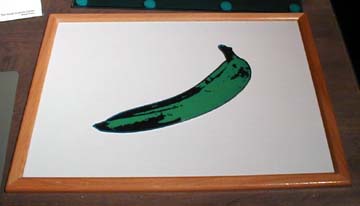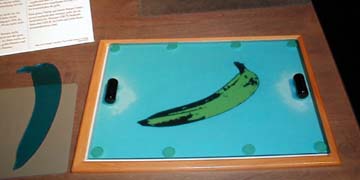
A Yellow image of a banana covered by a form fitting cyan filter.

A yellow image of a banana covered by a sheet of cyan
filter.
A yellow banana can appear to be yellow or green when viewed through a cyan filter.


A yellow image of a banana covered by a sheet of cyan
filter.
Introduction
The exact same wavelength combination can appear to be different colors depending on the color of its surroundings.
Material
Yellow acetate transparency (at least 20 cm x 20
cm.) or yellow paper
Cyan acetate transparency (bluish will do.)
White paper.
scissors
A pen that will write on the transparency.
optional, overhead projector
Assembly
Draw a simple outline of a banana on the white
paper.
Trace the outline onto the edge of the yellow transparency twice.
Trace the outline onto the edge of the cyan transparency.
Cut out the two yellow and the one cyan bananas.
To Do and Notice
Version 1 Overhead projector
Place the yellow banana on the overhead projector.
Notice that the color of the banana is yellow.
Place the cyan banana shape on top of the yellow banana shape.
Notice that the color of the banana is green.
Remove the cyan banana and cover the yellow banana with the entire square sheet of the cyan banana.
Notice that the color of the banana is yellow.
Place the two yellow bananas on the overhead projector. Separate them well.
Cover one yellow banana with a cyan banana, cover the other yellow banana with the cyan sheet.
Notice that the color of one banana is yellow and the second is green.
Notice that for both bananas the light from the projector goes through exactly the same filters.
What's Going On?
Our visual system automatically adjusts its perception of color to take into account the color of the illuminating light source. This is called color constancy.
The visual system does this by trying to identify white.
When a colored object is surrounded by cyan the eye-brain adjusts its perception by assuming that the illuminating light source is cyan. It subtracts cyan from its perception of color. This makes the green banana appear yellow.
Etc.
When early Mars observers looked at Mars they saw that a wave of green spread down from the Martian North pole each spring. This wave of green was the result of gray dust being blown away from the pole. The contrast between the red surface of mars and the gray dust lead the visual system to see the gray as green.
|
Scientific Explorations with Paul Doherty |
|
18 May 2000 |